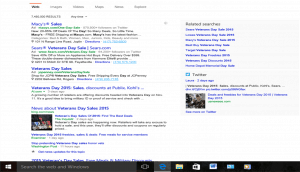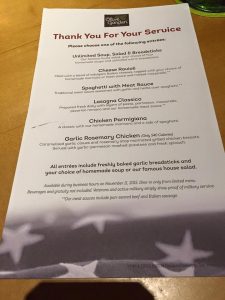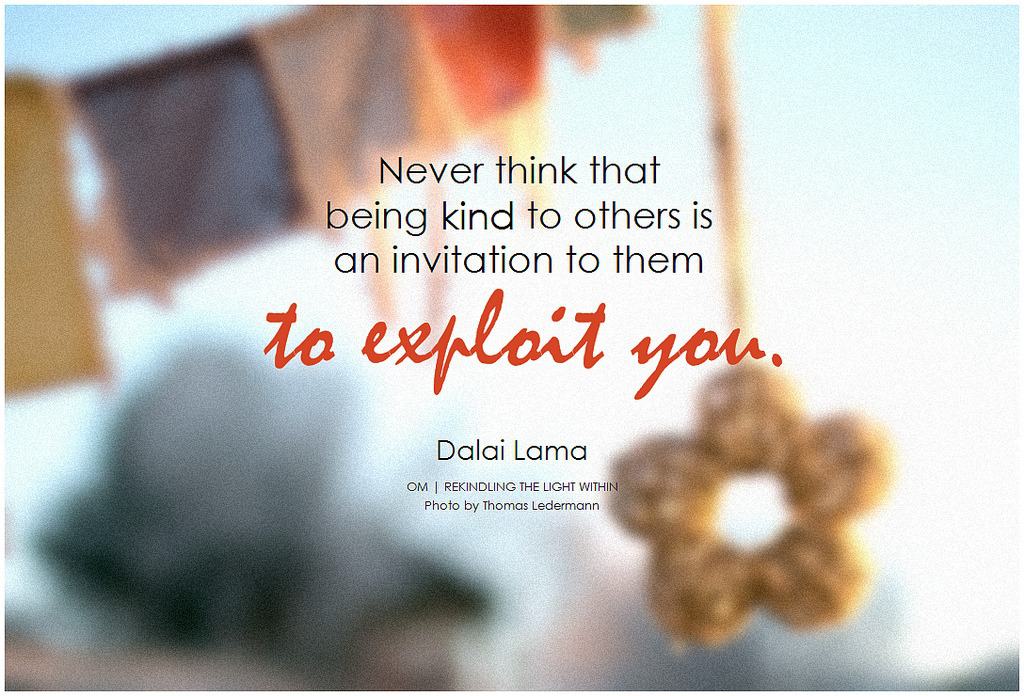As I am working through my Facebook feed this week, I was surprised to see the number of ads and businesses that were running specials for Veteran’s Day. I suppose I am used to seeing the Sears Veteran’s Day sale ad or Lowe’s appliance sales that have come out every year since I was little but, this year, it seemed like there were more than ever.

I haven’t done analytics on it to confirm if there was a substantial increase, but very well could have been that I was more keenly aware because of the amount of snackable information I get through my social feeds.
It was also brought to my attention because one of my friends said it would be hard to find a dinner location that did not offer free dinner for veterans, as they would all be packed…on a Wednesday night in Northwest Arkansas, that is quite unheard of.
Lastly, what got me thinking was sitting in a Veteran’s day event where former General Stanley McChrystal was speaking about how Americans have changed the way we support our veterans.
Thankfully, gone are the days when people are lined up at the airport to shame our veterans as they come home from war but, are we sure our actions to recognize them and call attention to their service are pure, with the best of intentions of honoring them?
Or are we taking people’s feelings out of the picture and capitalizing on a holiday, an event or someone’s unfortunate circumstances?
How do you know when you truly honoring or when you are exploiting?

How do you know? Well, it’s as simple as asking the question.
When looking at this past Veteran’s day, it’s not hard to find a veteran as you are walking through Walmart, driving your car on the highway or sitting in church services as many have jackets, hats bumper stickers or other items that signify their pride in service or respect for those that did not make it home.
While it might not make sense to roll down your car window and yell a question out at a stoplight, some of you have businesses where you get to interact with your customer base.
We have talked in previous blogs about the importance of talking to your customers (How to write to the customer 101:Consumer insights for targeted website content) and this is a great one to ask.
“Excuse me ma’am/sir. I see you are wearing a POW-MIA hat. Are you a veteran?
Well, thank you so much for your service. In honor of our veteran customers, we were thinking about providing a discount of 10%. If we did that do you think you or your fellow servicemen would appreciate something like that?
If not, then what would you appreciate? Ok, thank you so much for your help.”
Asking those questions of 12qmultiple customers not only gets you closer to the “right” answer but also helps your customers feel that their opinions matter to you.
How to get feedback with no face to face customer interactions
What if you are not face-to-face with your customers? Depending upon the customer base you are looking for, you may have these types of people in your life that you can ask questions of, but if there are not, there are other ways to find them.
In the case of veterans, you can call any support agency or organization that supports them or you can find other Arkansas organizations. These organizations were created to help veterans and help those that want to help veterans. They are usually also run by veterans themselves and are great resources.
When looking for other types of customers, go where they go or partner with another business who caters to these customers:
- Looking for moms for mother’s day – Maternity stores, baby stores, daycares, grocery stores, schools
- Looking for dads for Father’s day – Sporting stores, fishing stores, grocery stores, men’s clothing stores
- Looking for teachers – Schools, supply stores like Moser’s, Office Depot or the stationary section at Walmart
- Looking for Grandparents – Retirement homes, early morning coffee or donut shops, libraries
These may be a bit stereotypical, but it wouldn’t be a stereotype if a lot of people didn’t do it and is a good way to find a large group of people if you need them.
Other things to think about
There are a few other things to think about when getting feedback on what you should and should not do:
- What you pick will not be good for everyone. You may poll 500 people that are good with your direction, but there may be one or two that think what you did was wrong. You need to be okay with this, but also try to make things right with those two customers that you offended. We all know that at times, one negative comment can outweigh 500 positive interactions with no comment.
- Never assume someone is a <blank>. Don’t assume every older woman is a mother or every older person is a veteran or every person with glasses is a teacher. These assumptions can get you into trouble. When in doubt, it’s best to ask.
- Treat others how they want to be treated, not how you think they want to be treated. As humans, we make a lot of assumptions about other people and what they truly want. Make sure your thoughts really represent what they want, not what you would want or what you assume they want.
- When in doubt, don’t do it. If you think what you are doing might be a bit off course with a segment of your customer base, don’t do it unless your business can take the impact of the consequences associated with your action. Make calculated risks, not blind risks.
In summary, make sure in everything you do, you are focused on honoring and valuing your customers. When your customers feel that you do this for them and not for yourself, you build loyalty and create an advocate that pays off exponentially.
If you like this and our other blogs, make sure to share them with your friends on social media. Thanks for reading!


 What all the buzz about? Top 10 buzzwords every small business owner should know
What all the buzz about? Top 10 buzzwords every small business owner should know
Leave a Reply